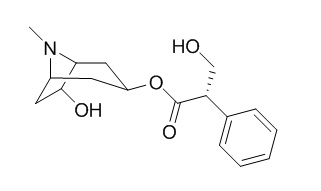6-beta-Hydroxyhyoscyamine
6-beta-Hydroxyhyoscyamine and 7 beta-hydroxyhyoscyamine exhibit similar affinities at the muscarinic receptor as scopolamine and atropine.
Inquire / Order:
manager@chemfaces.com
Technical Inquiries:
service@chemfaces.com
Tel:
+86-27-84237783
Fax:
+86-27-84254680
Address:
1 Building, No. 83, CheCheng Rd., Wuhan Economic and Technological Development Zone, Wuhan, Hubei 430056, PRC
Providing storage is as stated on the product vial and the vial is kept tightly sealed, the product can be stored for up to
24 months(2-8C).
Wherever possible, you should prepare and use solutions on the same day. However, if you need to make up stock solutions in advance, we recommend that you store the solution as aliquots in tightly sealed vials at -20C. Generally, these will be useable for up to two weeks. Before use, and prior to opening the vial we recommend that you allow your product to equilibrate to room temperature for at least 1 hour.
Need more advice on solubility, usage and handling? Please email to: service@chemfaces.com
The packaging of the product may have turned upside down during transportation, resulting in the natural compounds adhering to the neck or cap of the vial. take the vial out of its packaging and gently shake to let the compounds fall to the bottom of the vial. for liquid products, centrifuge at 200-500 RPM to gather the liquid at the bottom of the vial. try to avoid loss or contamination during handling.
Vietnam Journal of Food Control.2022, 5(3):pp.488-497.
J Pharmaceut Biomed2020, 178:112894
Front Aging Neurosci.2018, 10:269
Front Immunol.2018, 9:2091
Food Chem.2020, 313:126079
Food Engineering Progress2019, 23(3)209-216
Int J Biol Macromol.2019, 126:653-661
Microchemical Journal2024, 200:110475
Heinrich Heine University Dusseldorf2021, 62203.
Appl Microbiol Biotechnol.2016, 100(9):3965-77
Related and Featured Products
Pharmazie. 1995 Jul;50(7):493-5.
Binding of tropane alkaloids to nicotinic and muscarinic acetylcholine receptors.[Pubmed:
7675895]
METHODS AND RESULTS:
Fourteen tropane and related alkaloids were analyzed for their affinity for nicotinic and/or muscarinic acetylcholine receptors. The biogenetic intermediates littorine, 6-beta-Hydroxyhyoscyamine, 7 beta-hydroxyhyoscyamine exhibit similar affinities at the muscarinic receptor as scopolamine and atropine.
CONCLUSIONS:
The quarternary derivatives N-methylatropine and N-methylscopolamine show the highest binding with IC50 values of less than 100 pM and 300 pM, respectively. The tropane alkaloids (including cocaine) also bind to the nicotinic acetylcholine receptor, albeit with much lower affinities.
Planta Med. 2005 Mar;71(3):249-53.
Molecular cloning, expression and characterization of hyoscyamine 6beta-hydroxylase from hairy roots of Anisodus tanguticus.[Pubmed:
15770546]
METHODS AND RESULTS:
Anisodus tanguticus, one of the indigenous Chinese ethnological medicinal plants of the Solanaceae, produces anticholinergic alkaloids such as hyoscyamine, 6 beta-hydroxyhyoscyamine and scopolamine. Hyoscyamine 6 beta-hydroxylase (H6H), a key enzyme in the biosynthetic pathway of scopolamine, catalyzes the hydroxylation of hyoscyamine and epoxide formation from 6-beta-Hydroxyhyoscyamine to generate scopolamine. A full-length cDNA of H6H has been isolated from A. tanguticus hairy roots. Nucleotide sequence analysis of the cloned cDNA revealed an open reading frame of 1035 bp encoding 344 amino acids with high homology to other known H6Hs. The equivalent amino acid sequence shows a typical motif of 2-oxoglutarate-dependent dioxygenase. The A. tanguticus H6H was expressed in Escherichia coli and purified for enzyme function analysis.
CONCLUSIONS:
This study characterized the recombinant AtH6H and showed it could generate scopolamine from hyoscyamine.
Kokuritsu Iyakuhin Shokuhin Eisei Kenkyusho Hokoku. 2002;(120):85-8.
Tropane alkaloids in auxin-independent root cultures of Physochlaina physaloides.[Pubmed:
12638187]
METHODS AND RESULTS:
Adventitious and hairy root cultures of Physochlaina physaloides were established. These roots grew well and produced high amounts of tropane alkaloids (particularly hyoscyamine and 6-beta-Hydroxyhyoscyamine) in auxin-free culture medium. The effects of basal media and temperature on the growth and alkaloid production of these roots were investigated.
CONCLUSIONS:
Both root cultures produced highest amount of tropane alkaloids in B5 medium though the optimum temperature for hairy roots were lower than that for adventitious roots.



